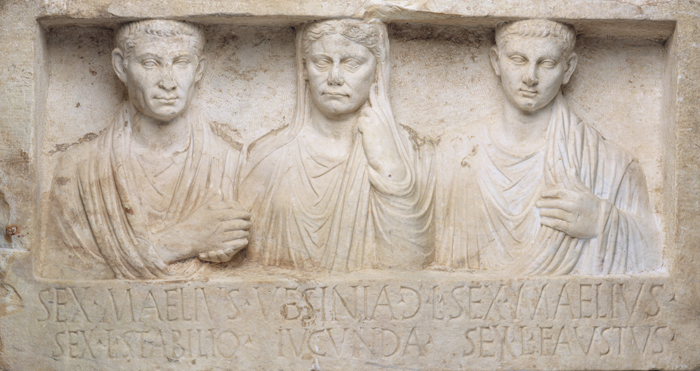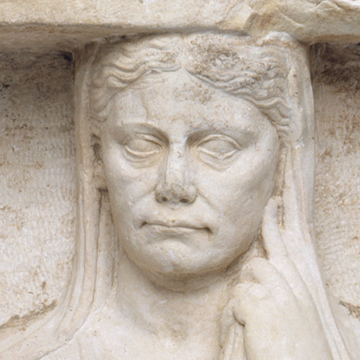
Funerary Monument
Roman, early 1st Century
(marble)
North Carolina Museum of Art, Raleigh
Let’s meet a group of people from long ago who worked hard to provide for themselves and their family.
Here we have a portrait of real people who lived two thousand years ago in the Roman Empire. When art portrays a real person, it is called a portrait. Do you know what the Roman Empire was? The Roman Empire was a military power that ruled over a vast territory. It ruled over a territory from England to the Persian Gulf and the Caspian Sea. The Roman Empire controlled the lives of people from all over the world, including Greeks, Egyptians, Africans, Jews and Christians. Not all of these people were citizens with legal rights, however. Some of them were enslaved who worked for their freedom.
Before we learn who these people were and what they are telling us, let me ask you if this is a painting? No, it is a piece of sculpture called a relief. What is this relief made of? It is made of marble. What type of tools can an artist use to carve marble? An artist can use a chisel and hammer as well as other tools to carve marble. Who were these people? Here’s a clue. These people were related to one another. How so? We believe they were a family. How can you tell the two figures on the left might have been a father and mother and the figure on the right their son? Do they look like each other? Perhaps the woman’s nose and the son’s nose look similar. Do you think they look similar? What about the two figures on the left? Do they look older than the figure on the right? Yes, they do. They have wrinkles on their foreheads. How can you tell the two figures on the left were husband and wife? They are holding hands, showing their connection and love for each other. Also, if you look carefully, you can see the woman is wearing a betrothal ring on her left hand and a cloak or bride’s veil draped over her head, both of which show her status. She is pushing her cloak to the side in a gesture of modesty and is pointing to her temple to show her virtue as well as her loyalty and devotion to her family.
What are these people telling us? Look along the bottom of the stone. Is something written there? The writing is in a language called Latin. It spells out the names of the husband and wife and their son. Their first names were Stabilio, Iucunda and Faustus. Look carefully. Do you see the letter L? The letter L stands for libertus (male) and liberta (female), meaning free. This tells us at one time they were enslaved but then gained their freedom. Do you wonder why the word Sex is spelled out before Stabilio and Faustus’ names? Sex is an abbreviation of Sextus, the name of Stabilio and Faustus’ former master. Since Stabilio and Faustus were freed slaves of Sextus, they proudly took their former master’s name as part of their own name. Stabilio’s name became legally Sextus Maelius Stabilio, and Faustus’ name became legally Sextus Maelius Faustus. Iucunda was a freed slave of a Roman matron named Vesinia.

Roman Funerary Monument Inscription
Do you wonder who enslaved people were in the ancient Roman Empire? Enslaved people in the ancient Roman Empire were often men and women from lands that the ancient Romans conquered. Even though Stabilio and his family could not hold office or serve in the army even after they were freed, they could still work hard to make a comfortable living. We know Stabilio and his family were successful at this because they were able to pay for this tomb. Perhaps their former master helped them by setting them up in business, as was often the practice in the ancient world. Scholars believe that perhaps Stabilio’s son Faustus paid for their tomb. I imagine Faustus was so proud they were free citizens in their community and could finally be legally recognized as a family, that he had this carving made for the front of their burial tomb.
Keep in mind—ancient sculpture was originally painted in bright colors. This tomb relief would have been painted bright red, at least in part. Imagine that! The tomb structure itself would have been free-standing and would have been made of brick and stone or a combination of the two. The tomb would have been set beside a road outside a city, perhaps along a major road outside Rome, and would have held the remains of several generations of this family. In this way, for years and years everyone who traveled on their way into the city would have seen this monument and would have remembered them as a family. Do you have anything in your family that shows you are a family? Do you have photographs of you and your family?
§
Would you like to see the Funerary Monument in person? All you have to do is visit the North Carolina Museum of Art in Raleigh, North Carolina. The Funerary Monument is in the Classical galleries at the museum. Or perhaps you would like a tour. Tours of the collection are given daily, except for Monday when the museum is closed to the public. If you prefer, you can contact the museum ahead of time and arrange for you and your friends to have a private tour. I’m sure a docent at the museum would be happy to show you and your friends the Funerary Monument and many other works of art. Whether you visit the museum on your own or have a tour with a docent, it will be well worth your time!
